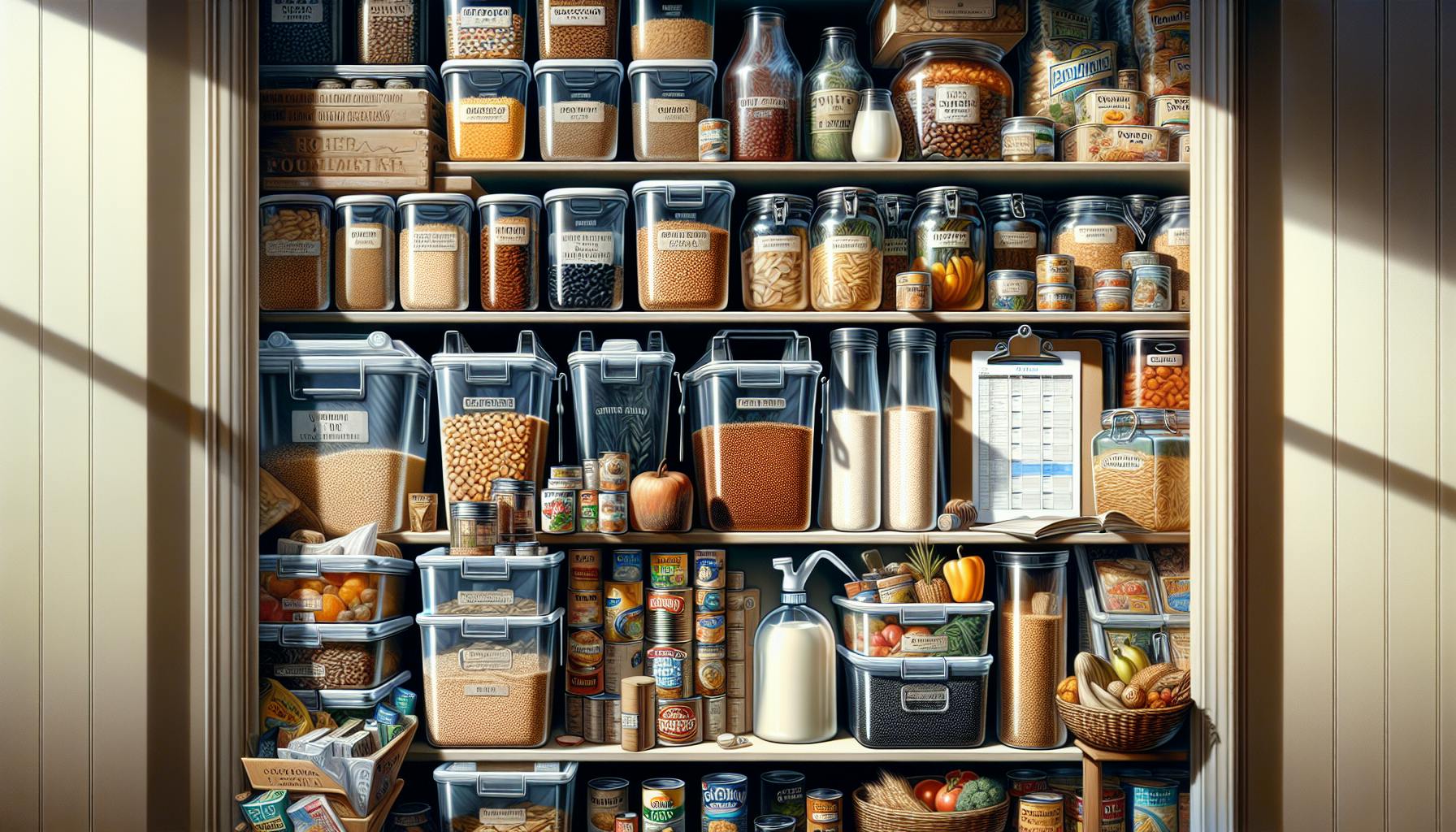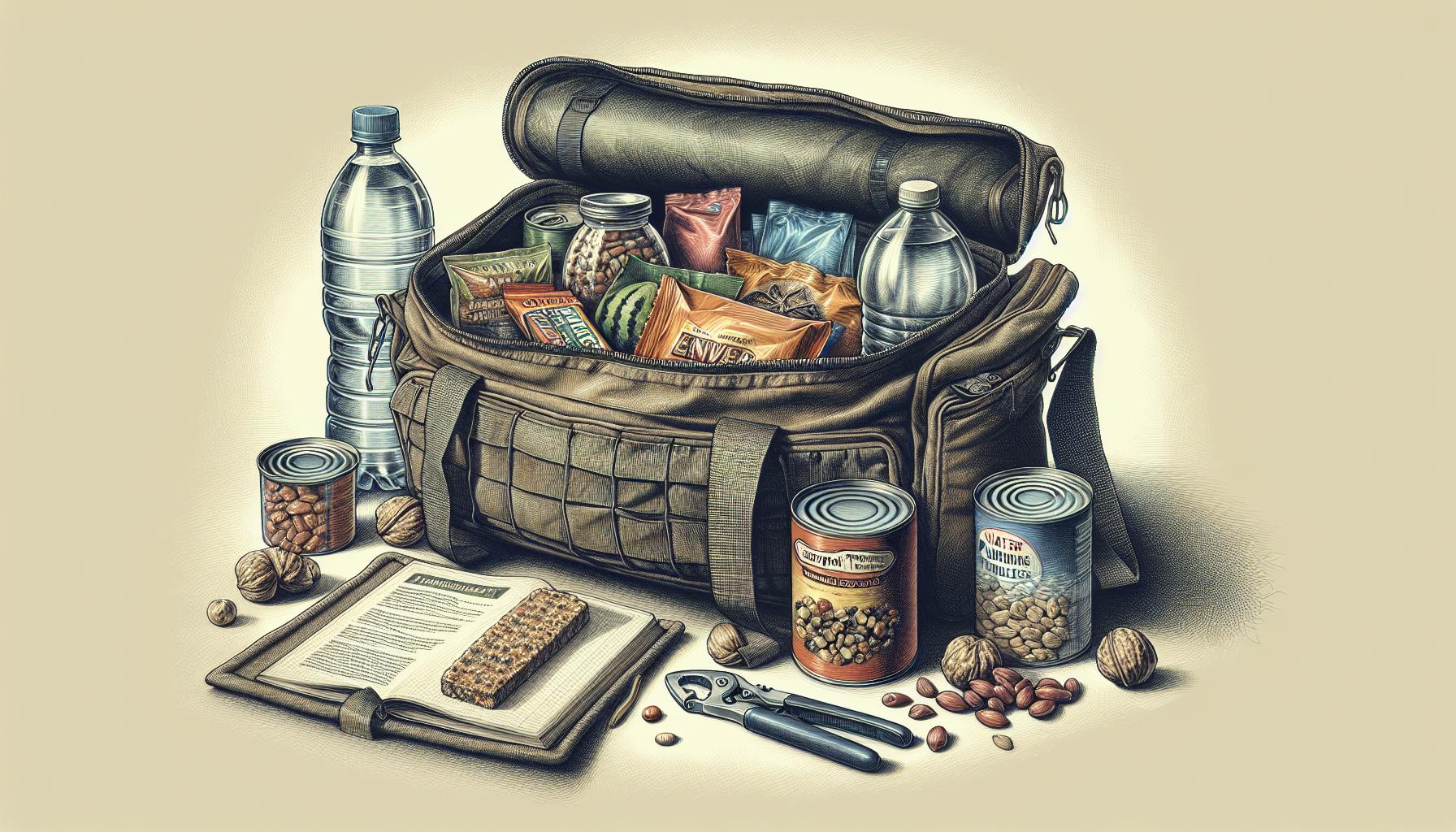Preparing an emergency food supply can be overwhelming. With so many options, it's hard to know where to start and what's truly essential.
This article will provide a complete guide to stocking an organic emergency food supply. You'll learn the core items your kit should include, the best options for nutrition and shelf life, and tips for long-term storage.
We'll cover storable carbohydrates, canned and jarred foods, freeze-dried essentials, healthy fats, plant-based proteins, herbs and spices, sprouting seeds, nutritional yeast, pemmican, water storage, milk alternatives, herbal teas, apple cider vinegar, vegetable broth, supplements, raw honey, sea salt, storage containers, and more.
Introduction to Organic Emergency Food Supply
Having an emergency food supply is crucial to being prepared for disasters or other situations that disrupt normal access to food. Choosing organic, non-GMO options provides important health and dietary benefits. This article will cover the key aspects of building an organic emergency food supply.
Understanding the Importance of Organic Supplies
Organic foods avoid toxic pesticides and GMO ingredients, making them healthier options, especially for long-term storage and consumption. Organic ingredients can provide more nutrients and antioxidants critical to health. As emergency situations are already stressful, minimizing toxin exposure through organic supplies supports wellbeing.
Calculating Your Organic Emergency Food Needs
Consider how many people you need to supply, for how long, and their unique dietary needs. Aim for a diverse range of organic emergency supplies to provide 2,000+ calories per person daily. Take inventory of current supplies and eat the oldest first, rotating new stock into your emergency stash.
Selecting the Best Organic Emergency Food Supply
Look for non-GMO, chemical-free disaster food kits with vegetables, fruits, grains and protein for balanced nutrition. Prioritize freeze-dried and dehydrated foods which deliver concentrated nutrition and 20-30 year shelf lives. Mylar pouches also seal out moisture and oxygen for 5-10 year lifespans.
Organic vs. Non-GMO Emergency Food Supply
Organic certification means no GMO crops or ingredients were used and the food was grown without toxic pesticides or chemicals. Non-GMO labels simply mean no genetically modified organisms were used. So organic is preferable, but non-GMO supplies are still a healthy emergency food choice over conventional options.
Preparing for Diverse Dietary Needs
Scan food labels for allergens like nuts, dairy and gluten to avoid. Seek organic plant-based protein sources, vitamin supplies and whole food options to cover more dietary restrictions. Having variety ensures your emergency food selection can be tailored to individual needs.
Core Components of an Organic Emergency Food Kit
An organic emergency food kit should focus on non-perishable foods with a long shelf life that provide nutritional value. Here are some of the core items to include:
Storable Organic Carbohydrates
- Whole grains like quinoa, amaranth, and buckwheat keep for years when properly stored and provide important nutrients.
- Organic pasta, rice, oats, and other grains are also good options. Go for whole grain whenever possible.
- Look for items with at least a 1-2 year shelf life unopened.
Canned and Jarred Organic Foods
- Stock up on canned vegetables, beans, fruits packed in juice rather than syrup, nut butters, and organic broths.
- Select low-sodium options when possible.
- Ensure cans and jar lids are undamaged.
Organic Freeze-Dried Food Essentials
- Freeze-dried foods are lightweight and retain more nutrients than other preservation methods.
- Seek out non-GMO, no added sugar or preservative versions.
- Focus on fruits, vegetables, beans, soups and meals to add variety.
Healthy Organic Fats and Oils
- Incorporate organic coconut oil, olive oil, nuts, seeds, and nut butters.
- Healthy fats provide energy and nutrients for maintaining health.
- Go for smaller containers to prevent spoilage after opening.
Best Organic Freeze-Dried Food Options
- Wise Company and Mountain House offer high-quality non-GMO freeze-dried ingredients and full meals.
- Augason Farms is another good source for organic freeze-dried vegetables and fruits.
- Focus on getting a variety of fruits, vegetables, beans, grains, and meat options.
Building an organic emergency food supply takes some research and planning, but stocking up on non-perishables with long shelf lives ensures you have nourishing options no matter the situation. Select items packed with nutrition that align with your needs and tastes.
Organic Meal Preparation and Ingredients
Round out your stockpile with hearty ingredients to craft nutritious meals.
Plant-Based Organic Protein Sources
Beans, lentils, peas, nuts and nut butters are all excellent non-animal sources of protein to have on hand. Chickpeas, black beans, kidney beans and lentils are versatile, nutrient-dense additions that have a long shelf life when stored properly. Almond butter, cashew butter and peanut butter also make good protein-packed additions.
When building your emergency food supply, aim for a variety of plant-based proteins to add calories, nutrition and staying power to any meal.
Organic Herbs, Spices, and Seasonings
Dried herbs and spices like oregano, basil, cumin and garlic powder greatly boost flavor, variety and nutrition without compromising shelf life. They take up little storage space, and a little goes a long way towards making bland ingredients taste delicious.
Organic seasonings provide antioxidant and anti-inflammatory benefits as well. Spice up your stockpile both literally and figuratively.
Organic Sprouting Seeds
Sprouting seeds like radish, broccoli and alfalfa are a great way to grow fresh greens right in your own home with just a jar and some water. They are an excellent source of vitamins and minerals to supplement your stockpile.
Look for certified organic sprouting seeds to avoid any chemical residues. They are perfect for microgreens, sandwiches, salads and more.
Nutritional Yeast and Superfoods
Nutritional yeast is naturally gluten-free and provides a savory, cheesy umami flavor along with protein, B vitamins and minerals. Other vitamin-packed superfoods like chia seeds, flaxseed, wheatgrass and spirulina powder also store well and provide nutritional insurance.
Organic Pemmican and Meat Alternatives
Traditional pemmican is made of lean meat jerky mixed with rendered fat. Look for organic grass-fed beef versions for the highest quality emergency protein.
There are also vegetarian pemmican alternatives made with nuts, seeds and dried fruit that provide ample nutrition. Meatless jerky made from mushrooms or textured vegetable protein can also add hearty protein if properly stored.
With the right mix of ingredients, you can craft nutritious and delicious meals from your organic emergency food supply. Emphasize variety, nutrition and shelf life as you build up your stockpile.
Hydration and Organic Beverages
Stay hydrated with shelf-stable organic beverages.
Essential Water Storage Tips
Having an emergency supply of water is critical. Here are some tips:
- Store tap water in sanitized plastic bottles or buy commercially bottled water. Rotate stock to keep it fresh.
- Allow for at least 1 gallon per person per day. Store at least a 2 week supply.
- Consider storing water filtration devices as a backup.
Organic Shelf-Stable Milk Alternatives
Powdered milk or canned coconut milk can provide nutrition:
- Powdered milk has a long shelf life. Reconstitute as needed.
- Canned coconut milk can be used for cooking or drinking.
Selection of Organic Herbal Teas
Keep a variety of caffeine-free, organic herbal teas on hand:
- Chamomile and peppermint soothe stomach issues.
- Rooibos is high in antioxidants.
Apple Cider Vinegar for Health and Hydration
Apple cider vinegar has uses beyond drinking:
- Dilute with water as a drink to boost hydration.
- Has antiseptic properties to clean surfaces.
Organic Vegetable Broth
Homemade or canned broth is useful for:
- Making nutritious soups and stews with storage ingredients.
- Cooking rice, quinoa, and other grains.
sbb-itb-b932644
Supplements for an Organic Emergency Diet
Essential for health when fresh produce is lacking.
Choosing a Quality Multivitamin
When building an emergency food supply, it's important to include a quality multivitamin to help fill potential nutritional gaps. Look for whole food-based multivitamins without synthetic fillers.
Shelf-Stable Probiotic Supplements
Probiotic supplements support healthy gut flora, which is essential for digestion and immunity. Seek out shelf-stable strains that don't require refrigeration.
Organic Electrolyte Solutions
Electrolytes like sodium, potassium and magnesium are vital for energy, hydration and muscle function. Organic electrolyte mixes can be stored long-term.
Vitamin C for Immune Support
Vitamin C strengthens the immune system and enhances iron absorption from plant-based foods. Consider powdered or tablet vitamin C supplements.
Vitamin D3 for Overall Health
Many people are deficient in the "sunshine vitamin". Vitamin D supports long-term health and can be taken in shelf-stable capsule form.
Additional Organic Supplies and Essentials
Round out your stockpile with these key items.
Raw Organic Honey
Natural sweetener with anti-inflammatory and antimicrobial properties. Raw organic honey can be a nutritious addition to your emergency food supply. Look for raw, unfiltered honey that has not been heat-treated, as this preserves more of the health-promoting enzymes and antioxidants. Honey has natural antibacterial and anti-inflammatory properties, making it useful both internally and externally. It can help soothe a sore throat, aid digestion, and even be applied topically to wounds. As a sweetener, raw honey gives you an alternative to processed sugar. It contains small amounts of nutrients like calcium, potassium, and vitamin C as well. With its indefinite shelf life, honey is a versatile item for your stockpile.
Organic Sea Salt
Essential for flavor and mineral balance. High quality sea salt, like Celtic sea salt or Himalayan pink salt, provides a range of essential trace minerals to support electrolyte balance and good health. Especially when physical demands may be higher during an emergency, replacing lost minerals through salty foods and drinks is key. Sea salt also makes stored food more palatable with its bright, pure flavor. Opt for coarse grains rather than extremely fine powder, which tends to cake and clump in humidity. Store in an airtight glass jar.
Apple Cider Vinegar Uses Beyond Hydration
Use as a nutritious cooking/dressing ingredient or antimicrobial cleaner. Raw, organic apple cider vinegar is valued for its many health and household benefits. It adds brightness and acidity to dressings, marinades, broths and more, allowing you to liven up bland stored foods. Apple cider vinegar is also antimicrobial due to its acetic acid content, making it useful for cleaning surfaces and produce. As a preparedness item, it has an extremely long shelf life. You can also utilize apple cider vinegar to make electrolyte drinks, combining with honey and sea salt. This supports hydration and mineral replenishment.
Organic Cooking Oils
High-heat oils like avocado and coconut for all cooking needs. Quality cooking oils are essential for good nutrition and palatability. Opt for organic, unrefined oils that retain more nutrients. Great choices are extra virgin olive oil, avocado oil and coconut oil. Olive oil excels for dressings, dips and low-to-medium heat cooking. The high smoke points of avocado and coconut oils allow high-heat searing and frying without producing harmful compounds. Measure out oils in small bottles for grab-and-go convenience. Oils can become rancid over time, so rotate stock as you use them.
Food-Grade Organic Storage Containers
Ensure no plastic chemical contamination. Proper food storage helps your emergency food last safely for years to come. Seek out BPA-free plastic containers, glass jars or stainless steel containers. Avoid cheap plastic tubs that can leach chemicals into food over time, especially with temperature fluctuations. Match lid types to containers to ensure the best seal against oxygen and moisture. Round shapes allow more efficient use of space compared to square. Place smaller jars and bottles in large storage bins to keep organized. Label everything clearly with contents and date.
Long-Term Storage Strategies for Organic Foods
Follow best practices for maximizing shelf life of organic emergency food supplies. Proper storage is key to preserving nutrients and freshness.
Storing in a Cool, Dark Environment
Keep food storage area at a constant temperature between 45-70°F, away from sunlight which can degrade quality over time. Stability is important.
Using Oxygen Absorbers for Preservation
Oxygen absorber packets remove oxygen from storage containers, preventing spoilage from oxidation. Less air contact equals longer shelf life.
The Role of Mylar Bags in Food Storage
Mylar bags create an impermeable barrier that oxygen cannot permeate. This barrier is crucial for long term food storage, keeping out moisture as well.
Keeping Track of Dates and Rotation
Tracking expiration or best-by dates, and rotating stock helps prevent waste. Store similar food items together for easy inventory. First in, first out.
Regular Inventory Checks and Management
Periodically check supplies for signs of spoilage, insect infestations or damage. Re-stock items as needed before they run out. Proper organization makes this easier.
Conclusion: Peace of Mind with Organic Emergency Food Supply
Creating an emergency food supply takes forethought but provides peace of mind when disaster strikes. The key is focusing your supply on nutrient-dense, non-perishable foods that will last, while following best practices for storage and longevity.
Here are some final tips for rounding out your organic emergency food supply with complete nutrition:
- Pair your shelf-stable staples with sprouting seeds to add fresh greens. Mung beans, lentils, quinoa and wheat berries can easily be sprouted indoors.
- Consider supplements like multivitamins, vitamin C and vitamin D to fill any nutritional gaps.
- Include the essential extras - a manual can opener, mess kits, utensils, paper plates, etc.
- Rotate and replace items as you use them to keep your supply fresh and effective.
- Store emergency food in a cool, dark place in airtight containers.
Following these best practices for storing and maintaining your supply will ensure you have peace of mind knowing you can weather any storm. Focus on nutrient density in your food choices, sprout seeds for fresh produce, utilize supplements and don't forget the can opener! With some planning and forethought, you can be fully prepared with an organic emergency food supply.


